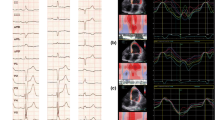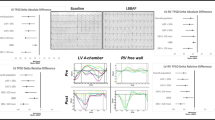Abstract
Ventricular pacing causes early myocardial shortening at the pacing site and pre-stretch at the opposing ventricular wall. This contraction pattern is energetically inefficient and may lead to decreased cardiac function. This study was designed to describe the acute effects of right ventricular apical (RVa) pacing on dyssynchrony and systolic function in human subjects with normal left ventricular (LV) function and compare these effects to pacing from alternate ventricular sites. Patients (n = 26) undergoing an electrophysiology evaluation were studied during atrial pacing (AAI) and dual chamber pacing from the RVa, left ventricular free wall (LVfw), and the combination of RVa and LVfw (BiV). Tissue Doppler imaging was used to measure intramural dyssynchrony by utilizing an integrated cross-correlation synchrony index (CCSI) from the apical 4-chamber view. RVa and BiV pacing significantly reduced systolic function as measured by longitudinal systolic contraction amplitude (SCAlong) (p < 0.05) and LV velocity time integral (VTI) (p < 0.05) compared to AAI and LVfw pacing. RVa (and to a lesser extent BiV) pacing resulted in septal and lateral intramural dyssynchrony as indicated by significantly (p < 0.05) lower CCSI values as compared to AAI. CCSI was significantly (p < 0.05) worse during RVa than LVfw pacing. In patients with normal LV function, acute ventricular pacing in the RVa alone, or in conjunction with LVfw pacing (BiV), results in impaired regional and global LV systolic function and intramural dyssynchrony as compared to LVfw pacing alone.



Similar content being viewed by others
References
Furman, S., & Schwedel, J. B. (1959). An intracardiac pacemaker for Stokes–Adams seizures. New England Journal of Medicine, 261, 943–948.
Badke, F. R., Boinay, P., & Covell, J. W. (1980). Effects of ventricular pacing on regional left ventricular performance in the dog. American Journal of Physiology, 238, H858–H867.
Burkhoff, D., Oikawa, R. Y., & Sagawa, K. (1986). Influence of pacing site on canine left ventricular contraction. American Journal of Physiology, 251, H428–H435.
Johnson, L., Kim, H. K., Tanabe, M., Gorcsan, J., Schwartzman, D., Schroff, S. G., et al. (2007). Differential effects of left ventricular pacing sites in an acute canine model of contraction dyssynchrony. American Journal of Physiology. Heart and Circulatory Physiology, 293, H3046–H3055.
Fei, L., Wrobleski, D., Grow, W., Vetter, A., Duffin, E. G., & Zipes, D. P. (1999). Effects of multisite ventricular pacing on cardiac function in normal dogs and dogs with heart failure. Journal of Cardiovascular Electrophysiology, 10(7), 935–946.
McVeigh, E. R., Prinzen, F. W., Wyman, B. T., Tsitlik, J. E., Halperin, H. R., & Hunter, W. C. (1998). Imaging asynchronous mechanical activation of the paced heart with tagged MRI. Magnetic Resonance in Medicine, 39, 507–513.
Park, R. C., Little, W. C., & O’Rourke, R. A. (1985). Effect of alteration of left ventricular activation sequence on the left ventricular end-systolic pressure–volume relation in closed-chest dogs. Circulation Research, 57, 706–717.
Prinzen, F. W., Van Oosterhout, M. F., Vanagt, W. Y., Storm, C., & Reneman, R. S. (1998). Optimization of ventricular function by improving the activation sequence during ventricular pacing. Pacing and Clinical Electrophysiology, 21, 2256–2260.
de Cock, C. C., Giudici, M. C., & Twisk, J. W. (2003). Comparison of the haemodynamic effects of right ventricular outflow-tract pacing with right ventricular apex pacing: a quantitative review. Europace, 5, 275–278.
Nahlawi, M., Waligora, M., Spies, S. M., Bonow, R. O., Kadish, A. H., & Goldberger, J. J. (2004). Left ventricular function during and after right ventricular pacing. Journal of the American College of Cardiology, 44, 1883–1888.
Schwaab, B., Frohlig, G., Alexander, C., Kindermann, M., Hellwig, N., Schwerdt, H., et al. (1999). Influence of right ventricular stimulation site on left ventricular function in atrial synchronous ventricular pacing. Journal of the American College of Cardiology, 33, 317–323.
Tse, H. F., & Lau, C. P. (1997). Long-term effect of right ventricular pacing on myocardial perfusion and function. Journal of the American College of Cardiology, 29, 744–749.
Prinzen, F. W., Hunter, W. C., Wyman, B. T., & McVeigh, E. R. (1999). Mapping of regional myocardial strain and work during ventricular pacing: experimental study using magnetic resonance imaging tagging. Journal of the American College of Cardiology, 33, 1735–1742.
Bank, A. J., Burns, K. V., Kelly, A. S., Thelen, A. M., Kaufman, C. L., & Adler, S. W. (2008). Echocardiographic improvements with pacemaker optimization in the chronic post cardiac resynchronization therapy setting. Clinical Medicine: Cardiology, 2, 65–74.
Sogaard, P., Egeblad, H., Pedersen, A. K., Kim, W. Y., Kristensen, B. O., Hansen, P. S., et al. (2002). Sequential versus simultaneous biventricular resynchronization for severe heart failure: evaluation by tissue Doppler imaging. Circulation, 106, 2078–2084.
Bank, A. J., Kaufman, C. K., Kelly, A. S., Burns, K. V., Adler, S. W., Rector, T. S., et al. (2009). Results of the PROspective MInnesota Study of ECHO/TDI in Cardiac Resynchronization Therapy (PROMISE-CRT) Study. Journal of Cardiac Failure, 15, 401–409.
Bax, J. J., Bleeker, G. B., Marwick, T. H., Molhoek, S. G., Boersma, E., Steendijk, P., et al. (2004). Left ventricular dyssynchrony predicts response and prognosis after cardiac resynchronization therapy. Journal of the American College of Cardiology, 44, 1834–1840.
Carlsson, M., Ugander, M., Mosen, H., Buhre, T., & Arheden, H. (2007). Atrioventricular plane displacement is the major contributor to left ventricular pumping in healthy adults, athletes, and patients with dilated cardiomyopathy. American Journal of Physiology. Heart and Circulatory Physiology, 292, H1452–H1459.
Leclercq, C., Gras, D., Le Helloco, A., Nicol, L., Mabo, P., & Daubert, C. (1995). Hemodynamic importance of preserving the normal sequence of ventricular activation in permanent cardiac pacing. American Heart Journal, 129, 1133–1141.
Fornwalt, B. K., Arita, T., Bhasin, M., Voulgaris, G., Merlina, J. D., Leon, A. R., et al. (2007). Cross-correlation quantification of dyssynchrony: a new method for quantifying the synchrony of contraction and relaxation of the heart. Journal of the American Society of Echocardiography, 20, 130–1337.
Lieberman, R., Padeletti, L., Schreuder, J., Jackson, K., Michelucci, A., Colella, A., et al. (2006). Ventricular pacing lead location alters systemic hemodynamics and left ventricular function in patients with and without reduced ejection fraction. Journal of the American College of Cardiology, 48, 1634–1641.
Wyman, B. T., Hunter, W. C., Prinzen, F. W., & McVeigh, E. R. (1999). Mapping propagation of mechanical activation in the paced heart with MRI tagging. American Journal of Physiology, 276, H881–H891.
Thelen, A., Kaufman, C. L., Burns, K., Kaiser, D. R., Kelly, A. S., & Bank, A. J. (2007). Response to cardiac resynchronization therapy differs between patients with and without previous right ventricular pacing. Circulation, 116(16), S 335.
Sweeney, M. O., & Prinzen, F. W. (2006). A new paradigm for physiologic ventricular pacing. Journal of the American College of Cardiology, 47, 282–288.
Puggioni, E., Brignole, M., Gammage, M., Soldati, E., Bongiorni, M. G., Simantirakis, E. N., et al. (2004). Acute comparative effect of right and left ventricular pacing in patients with permanent atrial fibrillation. Journal of the American College of Cardiology, 43, 234–238.
Doshi, R. N., Daoud, E. G., Fellows, C., Turk, K., Duran, A., Hamdan, M. H., et al. (2005). Left ventricular-based cardiac stimulation post AV nodal ablation evaluation (the PAVE study). Journal of Cardiovascular Electrophysiology, 16, 1160–1165.
Funding Source
This study was funded by Medtronic, Inc., Minneapolis, Minnesota.
Disclosures
Dr. Bank receives honoraria and research grant support from Medtronic and Boston Scientific. Dr. Schwartzman is a consultant and receives research grant support from Medtronic and receives grant support from St. Jude Medical. Mr. Burns and Dr. Johnson have no disclosures. Dr. Kaufman received honoraria and research grant support from Medtronic and Boston Scientific. Dr. Adler receives honoraria and research grant support from Medtronic, Boston Scientific and St. Jude Medical. Dr. Kelly received research grant support from Medtronic and Boston Scientific. Dr. Kaiser was formerly an employee of Medtronic.
Author information
Authors and Affiliations
Corresponding author
Rights and permissions
About this article
Cite this article
Bank, A.J., Schwartzman, D.S., Burns, K.V. et al. Intramural Dyssynchrony from Acute Right Ventricular Apical Pacing in Human Subjects with Normal Left Ventricular Function. J. of Cardiovasc. Trans. Res. 3, 321–329 (2010). https://doi.org/10.1007/s12265-010-9176-8
Received:
Accepted:
Published:
Issue Date:
DOI: https://doi.org/10.1007/s12265-010-9176-8




